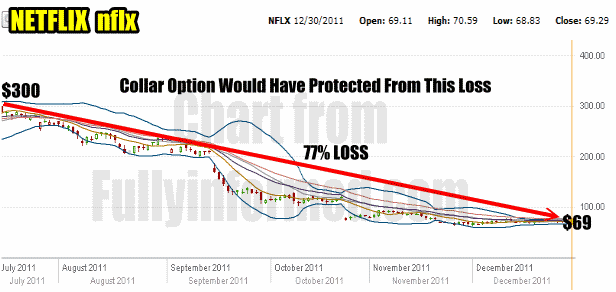Collar Option or Married Put is a great strategy. I get asked all the time when does a collar strategy not work. It’s the wrong question to ask because a collar option or married put works all the time if your goal is to insure your stock against loss whether you build a long term position or are a short term investor who has a climbing stock and want to protect it against a pull back, which invariably it will have. Therefore a collar option or married put is designed for a bull or bear market depending on the goals of the investor. I often stress the same things, the importance of having a plan, the importance of strategy, treating investing like a business. A collar strategy or married put must have all three of these factors in order to be successful and they can be incredibly successful if applied properly. A collar strategy or married put can make investing interesting, highly profitable and dare I say fun.
I have already written about using the collar strategy in a bear market environment in my article Teach The Bear New Tricks Using A Collar Option. In that article I focused on those investors who want protection in a bear market. But collars or the married put work well in bull or bear if the strategy is applied properly.
Collar Option Or Married Put Explained
To quickly summarize, if you are a long-term investor and only looking to earn the dividend from the stock and could care less where the stock moves then you do not need a collar option. I think it is always poor to not have protection but that’s just me. Many investors buying a stock such as Johnson and Johnson Stock purely for the annually increasing dividend have no interest in ever getting their original capital returned. Many families have purchased stocks and held them within the family from successive generations. Those families probably never purchased a collar option.
Collar Option or Married Put Same Thing
You probably noticed that I keep mentioning Collar Option or Married Put together. It’s because they are the same thing.
Collar Option or Married Put Defined
Basically a stock is purchased and a protective put is bought to limit the losses on the stock position. If the stock falls below the put, the put gives the investor the right to sell the stock at an established price. For example an investor buys XYZ Stock at $60.00 and buys a $60.00 put. If the stock falls below $60.00, the investor has the right to sell the stock for $60.00 right up until the put option expires.
Collar Option or Married Put Is Term Insurance
Think of a collar option or married put as term insurance. With term insurance an individual will protect his/her life for a period of 1 to 5 or longer years. When the time period expires, the individual is no longer insured. If they die while insured they collect the insurance. If they outlive the time period they do not receive any payment.
In the case of a collar option or married put an individual insures the value of his stock at a set price by purchasing the put option. That collar option has an expiry of anywhere from a month (or week on some stocks) up to two years on some stocks. For the length of period bought, the put offers insurance to the purchaser that their stock is insured at the price which the insured bought the option strike. If the stock falls during that period the investor collects his “insurance” by being able to sell his stock at the put price strike. Once that put option expires the investor is no longer insured. He can purchase another put option at any time to once more insure his stock.

Collar Option or Married Put would have protected an investor from this loss in Netflix Stock
When Does A Collar Option Not Work
To cover this common question again, I would say that a collar option does not work when an investor fails to use it properly or for the right reasons. I have received over 400 emails since my first article on collar strategies asking this same question. I therefore thought I would show how I use the collar option or married put successfully in my investing through a variety of strategies.
Collar Option or Married Put Strategies Implemented
Every stock has ups and downs. That’s a fact about investing. Stocks are risky assets but indeed the whole financial world is full of risk. Insurance is a means to protect against risk. Insurance though has a price to be paid and that is the trade off. But implemented properly a collar option or married put can provide significant downside protection and guarantee a profit. Again it comes back to the different goals of the investor.
I plan to write a series of articles looking at a variety of Collar Option Strategies or Married Put Strategies To Assist Readers. As I write each of those articles I will link them to this page to assist readers. This will become my Collar Option Strategy Index.
Articles Dealing With Collar Option Strategies or Married Put Strategies
1) Teach The Bear New Tricks Using A Collar Option
As mentioned previously this article looks at using a collar option during a bear market to protect a stock position.
2) Collar Option or Married Put For Long Term Dividend Stock Investors
This article looks at the collar option for those investors who are building a dividend income portfolio, never want to give up their shares but seek to have their original invested capital returned as quickly as possible for further dividend investing.

